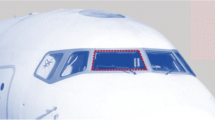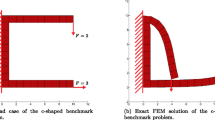Abstract
In this paper, the topology optimization method is extended to arrive at the desired deformation behavior within local structural domains by distinguishing and suppressing specific deformation in a certain direction. Compared to the standard topology optimization and existing shape preserving design method, the contribution of this paper is twofold. First, Artificial Weak Elements (AWE) are defined and attached to the appropriate local domain. The strain energies of the AWE are calculated as a measurement to describe the deformation behavior quantitatively. Second, particular orthotropic material properties are defined for the AWE according to the given direction of the desired deformation, which formulate Orthotropic Artificial Weak Elements (AWEort). By introducing the constraint on the strain energy of the AWEort into a standard compliance based topology optimization, the deformation in the corresponding direction is suppressed, resulting in the desired deformation behavior. Several numerical examples are tested and compared to the standard topological design to illustrate the effect of the directional deformation behavior design.
























Similar content being viewed by others
References
Bendsøe MP, Kikuchi N (1988) Generating optimal topologies in structural design using a homogenization method. Comput Methods Appl Mech Eng 71:197–224
Deaton J, Grandhi R (2014) A survey of structural and multidisciplinary continuum topology optimization: post 2000. Struct Multidiscip Optim 49:1–38. https://doi.org/10.1007/s00158-013-0956-z
Gao T, Qiu L, Zhang W (2017) Topology optimization of continuum structures subjected to the variance constraint of reaction forces. Struct Multidiscip Optim. https://doi.org/10.1007/s00158-017-1742-0
Gonlinval JC (2011) Mechanical design of turbojet engines - an introduction. Textbook of University of Liege, AERO0015–1
Guo X, Cheng GD (2010) Recent development in structural design and optimization. Acta Mech Sinica 26:807–823. https://doi.org/10.1007/s10409-010-0395-7
Hou J, Zhu JH, He F, Zhang WH (2017) Topology optimization of stiffeners layout with constraints on the multi-fastener joint loads. Chin J Aeronaut. https://doi.org/10.1016/j.cja.2017.05.005
Huang X, Xie YM (2009) Evolutionary topology optimization of continuum structures with an additional displacement constraint. Struct Multidiscip Optim 40:409–416
James KA, Waisman H (2016) Layout design of a bi-stable cardiovascular stent using topology optimization. Comput Methods Appl Mech Eng. https://doi.org/10.1016/j.cma.2016.02.036
Kim SI, Kim YY (2014) Topology optimization of planar linkage mechanisms. Int J Numer Methods Eng 98:265–286
Li Q, Steven GP, Xie YM (1999) Displacement minimization of thermoelastic structures by evolutionary thickness design. Comput Methods Appl Mech Eng 179:361–378
Maute K, Allen M (2004) Conceptual design of aeroelastic structures by topology optimization. Struct Multidiscip Optim 27:27–42
Nam SJ, Jang GW, Kim YY (2012) The spring-connected rigid block model based automatic synthesis of planar linkage mechanisms: numerical issues and remedies. J Mech Des 134:051002
Pedersen CB, Buhl T, Sigmund O (2001) Topology synthesis of large displacement compliant mechanisms. Int J Numer Methods Eng 50:2683–2705
Qiao H, Liu S (2013) Topology optimization by minimizing the geometric average displacement. Eng Optim 45:1–18
Radovcic Y, Remouchamps A (2002) BOSS Quattro: an open system for parametric design. Struct Multidiscip Optim 23:140–152
Rong JH, Yi JH (2010) A structural topological optimization method for multi-displacement constraints and any initial topology configuration. Acta Mech Sinica 26:735–744. https://doi.org/10.1007/s10409-010-0369-9
Sakata S, Ashida F (2009) Perturbation-based successive approximate topology optimization for a displacement minimization problem. Comput Methods Appl Mech Eng 199:148–157
Sigmund O (1997) On the Design of Compliant Mechanisms Using Topology Optimization. Mech Struct Mach 25:493–524
Sigmund O (2001) A 99 line topology optimization code written in Matlab. Struct Multidiscip Optim 21:120–127
Sigmund O (2007) Morphology-based black and white filters for topology optimization. Struct Multidiscip Optim 33:401–424. https://doi.org/10.1007/s00158-006-0087-x
Sigmund O, Maute K (2013) Topology optimization approaches. Struct Multidiscip Optim 48:1031–1055. https://doi.org/10.1007/s00158-013-0978-6
Sigmund O, Petersson J (1998) Numerical instabilities in topology optimization: a survey on procedures dealing with checkerboards, mesh-dependencies and local minima. Structural Optimization 16:68–75
Stanford B, Beran P (2012) Optimal compliant flapping mechanism topologies with multiple load cases. J Mech Des 134:51007
Stanford B, Beran P, Kobayashi M (2013) Simultaneous topology optimization of membrane wings and their compliant flapping mechanisms. AIAA J 51:1431–1441
Svanberg K (2007) On a globally convergent version of MMA. 7th World Congress on structural and multidisciplinary optimization. COEX Seoul, Korea
Tsai TD, Cheng CC (2013) Structural design for desired eigenfrequencies and mode shapes using topology optimization. Struct Multidiscip Optim 47:673–686
Wang MY, Wang X, Guo D (2003) A level set method for structural topology optimization. Comput Methods Appl Mech Eng 192:227–246
Wang MY, Chen S, Wang X, Mei Y (2005) Design of multimaterial compliant mechanisms using level-set methods. J Mech Des 127:941–956
Xia Q, Shi T, Wang MY, Liu S (2010) A level set based method for the optimization of cast part. Struct Multidiscip Optim 41:735–747
Xie YM, Steven GP (1993) A simple evolutionary procedure for structural optimization. Comput Struct 49:885–896
Yan J, Cheng GD, Liu L (2008) A uniform optimum material based model for concurrent optimization of thermoelastic structures and materials. Int J Simul Multidiscip Des Optim 2:259–266
Zhang JX, Wang B, Niu F (2014) Optimal design of concentrated force diffusion for short shell structure using hierarchical radial ribs (in Chinese). Chinese J Comput Mech 31(2):141–148
Zhu JH, Zhang WH, Beckers P (2009) Inergrated layout design of multi-componment system. Int J Number Methods Eng 78:631–651
Zhu JH, Li Y, Zhang WH, Hou J (2015) Shape preserving design with structural topology optimization. Struct Multidiscip Optim 53(4):893–906. https://doi.org/10.1007/s00158-015-1364-3
Zhu JH, Zhang WH, Xia L (2016) Topology optimization in aircraft and aerospace structures design. Arch Comput Meth Eng 23:595–622
Zhu JH, Guo WJ, Zhang WH, Liu T (2017) Integrated layout and topology optimization design of multi-frame and multi-component fuselage structure systems. Struct Multidiscip Optim 56(1):21–45
Zuo ZH, Xie YM (2014) Evolutionary topology optimization of continuum structures with a global displacement control. Comput Aided Des 56:58–67
Acknowledgments
This work is supported by National Natural Science Foundation of China (11432011, 11620101002), National Key Research and Development Program (2017YFB1102800), Key Research and Development Program of Shaanxi (S2017-ZDYF-ZDXM-GY-0035).
Author information
Authors and Affiliations
Corresponding authors
Rights and permissions
About this article
Cite this article
Li, Y., Zhu, J.H., Zhang, W.H. et al. Structural topology optimization for directional deformation behavior design with the orthotropic artificial weak element method. Struct Multidisc Optim 57, 1251–1266 (2018). https://doi.org/10.1007/s00158-017-1808-z
Received:
Revised:
Accepted:
Published:
Issue Date:
DOI: https://doi.org/10.1007/s00158-017-1808-z




